In search of a new white
A few weeks ago I wrote a blog entry about Titanium White (PW6) and Zinc White (PW4) and that got me thinking. Aren’t there alternatives? Chalk maybe? Or some kind of filler?
On the internet I found a list: The Color of Art Pigments Database. You need to take a good look at how it works. Once you think you got it, you don’t understand much of it, but enough to learn that the white pigments are not only “dangerous”, such as lead white, titanium white and zinc white.
At Verfmolen de Kat I bought several white powders to test them all out. My search for new white has begun. I’ve used gum arabic as a binding agent and diluted it with water. Three spots can be seen in the test: top left the powder has only been mixed with gum arabic to form a paste, top right the paste has been diluted with some water and below with a lot of water.
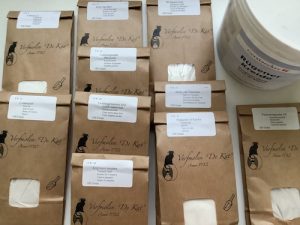
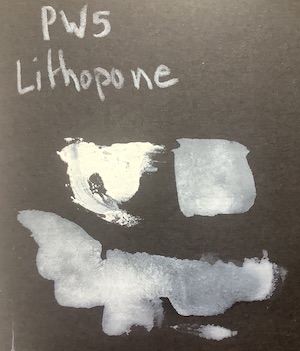
First of all, there is Lithopone (PW5), also called opaque white, and there is something strange about it. Some sites state that this pigment is often used in inferior, hobby or study paint as a kind of filler to save the real, more expensive pigment.
Elsewhere there is talk of the fine qualities of this pigment. Further research raises even more questions.
It is not dangerous, but it does contain the dangerous zinc sulfate solution. Yes, exactly that zinc that is so life-threatening for aquatic organisms. And there is no danger sign here! The composition is also unclear: At one site lithopone consists of 28 to 30% zinc sulfide and 72 to 70% barium sulphate, at another site the composition is exactly the other way around. I just hope that there is a typo on that last site.
It is a pity that the first new alternative immediately raises so many questions and alarm bells go off because of the zinc it contains; It is nice stuff and lives up to its (nick) name (opaque white).
The next pigments I would like to discuss are PW18 and PW19. These are clearly collection containers for all types of chalk. Have you always wondered why, when manufacturers use the same pigment numbers, there can still be such a difference in color? Besides the fact that it may have to do with the quality of the pigment, or the greater or lesser degree of fillers, it also has to do with where the pigment comes from and which pigment it is exactly.
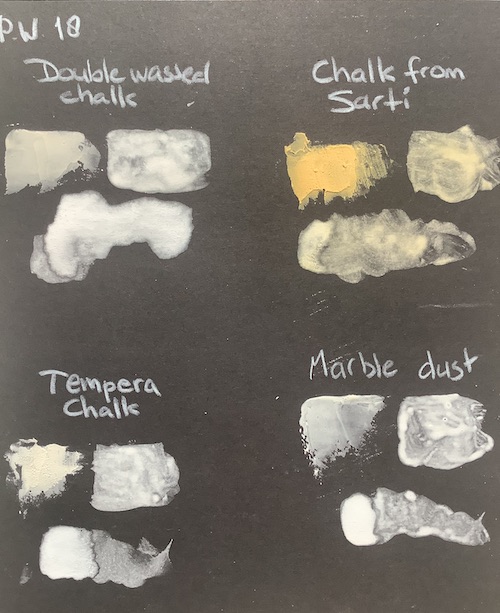
Under PW18 I found the following types of chalk (there are more, but I could easily get these):
- Double washed chalk
- Tempera chalk
- Marble dust
- Chalk from Sarti
Except for Chalk from Sarti, they are all white and I already know from experience that marble dust hardly influences the color of other pigments. It is the case with all three that they become whiter when they have more water. Perhaps this has something to do with the ratio of gum arabic and water and not so much with the pigment.
What exactly Chalk from Sarti is doing here in this group is unclear to me: it is more of a yellow, could even possibly pass for the much wanted Naples yellow.
The next group of calcareous species is PW 19:
- Kaolin or China clay
- Ruegener Chalk
- Earth of Vincenza
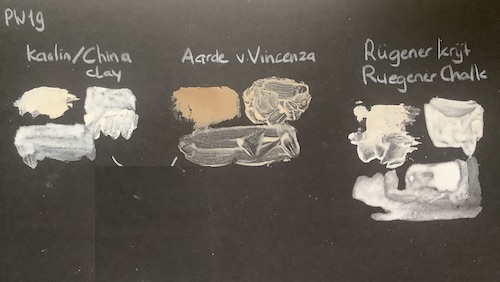
Again, here’s a stranger in our midst: Earth of Vincenza. It is more brownish and after diluting with water it could be a nice skin tone.
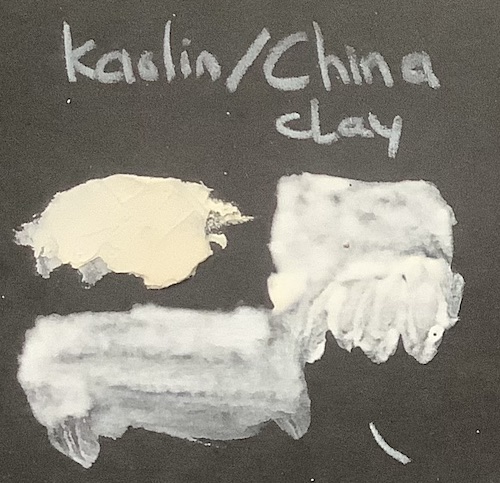
What I am very pleased with is the Kaolin/Chinese clay. While searching the internet, I hoped that it would not become another zinc pitfall, because zinc white is also sometimes called Chinese white. My hope was answered: it is not zinc. This type of soft clay is widely used in facial masks and other cosmetic products. It has a high absorption capacity, which makes it a great ingredient for use in self-preservation products.
Because it absorbs a lot of water, bacteria, fungi and yeasts have no chance to multiply. Perhaps Kaolin has more to offer than just being a white pigment. To be continued….
Ruegener chalk is fairly well known. It is a kind of off white, a bit between titanium and buf titanium. It consists largely of pure calcium carbonate (98.2%), Ruegener chalk also contains silicon, magnesium, aluminum, iron, iodine and phosphorus compounds. If you mix it with water it becomes opaque, with oil it becomes transparent.
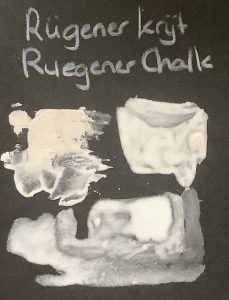
This chalk is also often used in cosmetic products. Yes, this could pass for my alternate white as well.
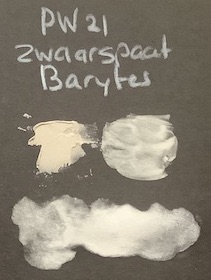
Then another misfit: Barytes (PW 21), also called permanent white, but it is the barium sulphate that is also in lithopone and does not really look white. Cream white I would like to name it. I especially like this pigment when mixed with other colors, as shown in the photo with blue ink.
All white pigment chalks give the ink a nice opaque finish, which is to be expected from a chalk. The chalk for tempera appears to be the most opaque and even makes the color a bit darker.
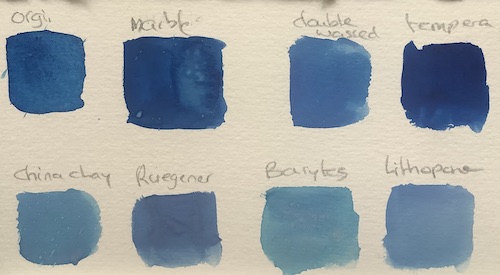
Of all the pigments tested, lithopone comes closest to the titanium white. But because of the ingredient zinc, I don’t want to use lithopone anymore. The other pigments are white (except for Sarti and Vincenza) but not as white as titanium or zinc.
But, I wonder, how often do I really just use the pure white titanium? Don’t I often mix it with another color? And didn’t I fall in love with the buff titanium because of its off white color?
I don’t have a favorite new white yet, they all have something.
At least I still have enough powders to explore.